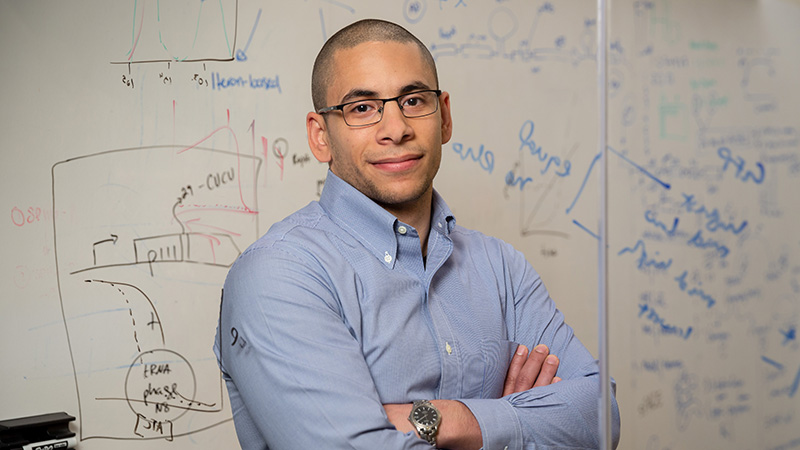What if we could go beyond biology’s natural limitations to address some of the biggest challenges our world faces today, like global warming or antibiotic resistance? Scripps Research assistant professor Ahmed Badran, PhD, is studying the most central biomolecular machines in living systems with the hopes of discovering transformative medicines and new approaches to combat climate change.
Badran sat down for an interview with the Science Changing Life podcast to discuss how synthetic biology may hold the answers to questions that evolutionary biology hasn’t yet been able to solve.

How did playing with Lego® sets get you thinking about science?
I’ve always thought about biology as being reasonably modular, and I think when you look at the flow of genetic information, you really do get a sense of this Lego-type feature. You have more or less the same building blocks that make up the nucleic acids and the proteins. And then what happens is biology puts them together in different combinations, which gives you wildly different outcomes as a result. And all of the different forms of life that we see on the planet are built using these same building blocks. So, this Lego mentality has been at the forefront of my mind ever since I started my career in science. How do you put the different Legos together? And how do you make new Legos?
How is your lab at Scripps Research manipulating nature’s building blocks?
One of our main projects is focused on engineering plants to improve their ability to fight climate change. Plants rely heavily on an enzyme called rubisco, which is critical in the steps of photosynthesis. It grabs carbon dioxide from the air and uses it to grow the vegetation we see all around us. The problem is that this enzyme is naturally inefficient and often makes molecular mistakes. One strategy we are developing is introducing new building blocks into this enzyme that could uncover new chemistry and dramatically enhance its activity. The other approach is to replay the tape of life by taking these ancestral enzymes and completely re-evolve them along different trajectories. Between these two strategies we think we can boost the power of biological systems to remove carbon dioxide from the atmosphere and thereby reduce global warming.
Where could these synthetic approaches also be used to discover new medicines?
We are currently engineering bacterial components in such a way that we could screen for new and more specific antibiotics. If we can find antimicrobial agents that only stop the cellular machinery from the bad bacteria and not our good bacteria, we can avoid the disruption to the microbiome that comes with current antibiotic regimens. By making the medicines more specific for each particular pathogen, we also think we can circumvent the growing problems around antibiotic resistance. The most important bacterial strain that we’re trying to address right now is called Acinetobacter baumannii, which can cause severe pneumonia or colonize open wounds. Recently we’ve had success in identifying new molecules that selectively block the protein-making factories from this organism. It’s still very much in its early stages, but things look promising.
When you’re not engineering molecules in the lab, how else do you spend your time?
Well, I don’t play with Legos anymore, but I’m very interested in video games where you can build complexity. One of my favorites games involves jumping between planets and discovering new organisms; another is a resource management game where the goal is to create the most efficient factory. Outside of games, I’m very much into sports. I’ve been swimming for about 25 years now, and it’s both relaxing and energizing.
Listen to Badran’s full interview on the Science Changing Life podcast.